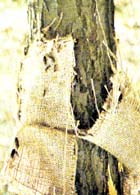
Gypsy moth larvae affected by NPV.
Natural Forms of Control
There are many different predators, parasitoids, and diseases that keep populations in control, but none that will eradicate the gypsy moth. Some known predators of the gypsy moth are birds, beetles, and spiders to name a few. A virus, nucleopolyhedrosis, NPV for short affects the tissues of the larvae causing it to die and form a v-shape. This virus has been effective in keeping populations under control but only when they are large in size. The most effective so far has been a fungus, Entomophaga maimaiga. This was first noticed in 1996 when it wiped out populations so much that there was no reportable defoliation for 1996 (see graph of defoliation).

A burlap band that has been opened up to show larvae inside.

Male moth traps are used to check populations of gypsy moths.
Control
There are many different things that can be done to control the gypsy moth. One of these is to put burlap bands around your trees. This will give the larvae a nice place to rest and prevent them from getting up the tree. The band needs to be checked and whatever found scraped into a bucket of soapy water. The pheromone given off by the female has been duplicated and used for male moth traps. These green boxes are used to determine if there are gypsy moth populations in a certain area. They are not usually a form of control, but can be used as one. It is called mass trapping, to do this a number of boxes are put up in a small area to disturb the mating cycle. There is such an excess of pheromones that the male gets confused and ends up not mating. Another thing you can do is to eliminate hiding places. Female moths like to find hiding places to lay their eggs. If there is a lot of stuff around your yard, pick it up or make sure to check for eggs in that also. If any eggs masses, larvae, pupae, or moths are found put them in soapy water. Why soapy water?! Well insects have sphericals on the sides of their bodies, which allow them to breathe. When put in water, surface tension on the spherical prevents water from flooding the insect's body. The soap however breaks down this surface tension cause the insect to drown. Different insecticides and chemicals are being tested for use on the gypsy moth. Aerial application is used in many areas to manage the populations.
Slow the Spread
This is a program implemented to slow the spread of gypsy moths to uninfested areas. One of the main ways that gypsy moths spread over long distances is people. Eggs can be laid on cars and trailers then unknowingly taken to a different area to hatch. The ballooning effect is a natural way that gypsy moths spread in the larvae stage. To do this they go to the top of the tree in the larval stage and hang from a silken thread. The wind picks up and carries them anywhere from a couple feet to a couple miles. To find out more about slow the spread and the gypsy moth visit the Virginia Tech gypsy moth website.